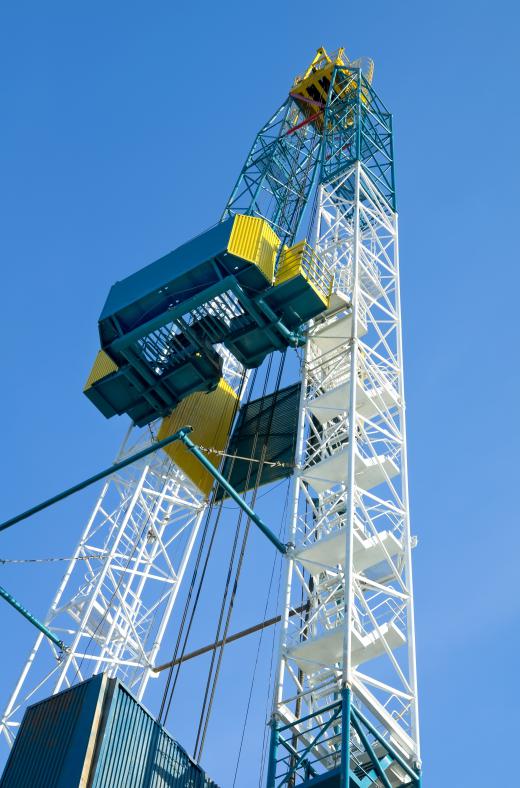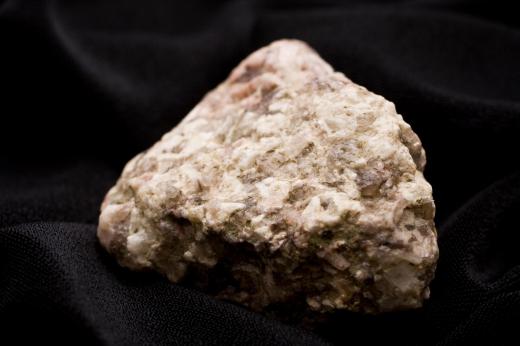What is the Deepest Hole Ever Drilled?
 Michael Anissimov
Michael Anissimov
The deepest hole ever drilled is the Kola Superdeep Borehole, on the Kola peninsula in the northwest corner of Russia, located near Finland. It was drilled for scientific research by the USSR. Like many large research holes, it had a number of offshoots from the central branch, and the deepest, SG-3, was 7.6 miles (12.262 km) deep. The borehole reached this depth in 1981. The temperature at this depth was 356°F (180°C), at which point the rock became more like a plastic than a solid, stopping further drilling.
Even though the hole in question was 7.6 miles (12.262 km) deep, it only penetrated a third of the Baltic continental crust. The rock at the bottom of the hole was about 2.7 billion years old, and samples brought from near the bottom contributed invaluably to the study of geology and geophysics at the time. The original depth goal was 9.32 miles (15,000 meters), but a faster-than-expected increase in temperature forced a premature halt to the project. If the hole had extended down to its planned depth, the projected temperature would have been 572°F (300°C), well over the maximum operating temperature of the drill bit.

The Kola Superdeep Borehole was the source of a tabloid rumor, started by a Finnish newspaper, that Russian researchers had burrowed through to Hell. The story was reproduced by several American tabloids. It stated that 9 miles (14.4 km) down into the Earth's crust (1.4 miles (2.25 km) deeper than the real depth), the scientists reached a pocket of air with a temperature of 2,000°F (1,093°C). Intrigued, they sent down a heat-tolerant microphone, which picked up the screams of the damned. The rumor was exacerbated when recordings of the alleged screams popped up on the Internet shortly thereafter.

Several interesting discoveries resulted from the hole. Pockets of water were found from time to time, prevented from ascending to the surface by a layer of impermeable rock. An excess of hydrogen was released from the drilling, which researchers described as "boiling" up from the surface of the hole. More details on the geology of the Baltic Shield were discovered. This area formed hundreds of millions of years ago when a supervolcano exploded and sent magma across a fair fraction of the continent.
AS FEATURED ON:
AS FEATURED ON:













Discussion Comments
If they drilled too deep and broke through the crust, they would pop the planet and we would shoot across the galaxy like a balloon until the earth looked like an unrolled condom somewhere in orbit around Wolf 359, maybe.
If the earth had a molten iron core as hot as the sun, then how can it possibly have a solid crust?
Nuclear? Hydrogen? You're missing the point. The entire planetary core is a nuclear reactor; it makes heat. Drill a hole, add water and add a turbine. Ta-da! You don't even need to add water beyond the start up because the steam becomes water again.
I've heard one of those tapes and I have to say it is pretty eerie. However, even if people believe in Hell, and think it's a physical place, they can't possibly think it's only seven miles below us, within our reach.
I suspect that people who want to be convinced of that kind of ridiculous urban legend will always let themselves be convinced, no matter how unlikely it is.
@arod2b42 - It's very unlikely that we'll be able to drill much deeper. I don't think we're anywhere close to have the technology to drill into that depth, considering how hot it gets.
I don't know whether there is something to be feared by going that deep or not. I think probably it's not that big of a deal in terms of potential disaster.
But, I don't think we'll ever find out in our lifetime as that kind of borehole drilling isn't going any further for a while.
Drilling that deep would definitely release an untold amount of pressure. Whether this is good or bad is unknown. One thing for sure, it would be a sight worth seeing!
I worry that if we were able to bore deeper than this, a natural disaster could occur. Although unheard of, it is possible that we could have man-made volcanoes due to a penetration into the thick layer between us and a large quantity of magma.
I find it surprising that so many people would believe that the damned were screaming into a microphone a few miles down. I figured this would have had to have been a hundred years ago, but it was just in 1981. Were people really that gullible 30 years ago? The internet seems to have had a positive effect on eliminating urban legends such as this.
Geothermal energy of this sort may be the fuel of the future. Instead of drilling for oil, we could all survive off of a few drills into the earth's crust. Nuclear reactors could be used to harvest the hydrogen power and provide energy for millions. This solution would be vastly more sustainable and healthy than our current system. The economy is not likely to jump on board anytime soon, however, because of the relative lack of money which could be garnered from this kind of venture. There would also be fewer wars.
Hydrogen!?! if we could mine that today... we do now have better technology
Post your comments